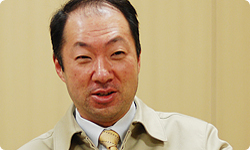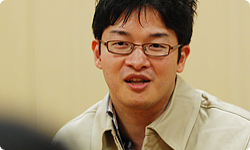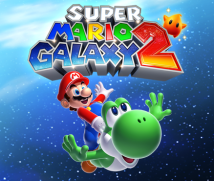4. Looking For the True Mario-Like Tune
Kondo-san, did you notice any changes in the way Yokota-san worked between the previous game and this one?
I thought he was being quite attentive to the lyrical parts. He also managed to carry over the atmosphere from the previous game, so it all seemed nice and unified.
So you were able to relax and just watch him work.
Right. And, a little while ago, Yokota-san said it was very important that Mario music be fun. I've always had a hard time communicating what makes Mario music the way it is; I can never put it into words. Then, just the other day, I gathered all the Entertainment Analysis & Development Division sound staff members together and gave everyone a chance to discuss things they'd noticed about making this sequel. During the session, a staff member commented that Mario music doesn't use minor chords7. 7In general, minor chords are said to be dark, and major chords are said to be bright.
Yes, I remember that.
The fact that minor chords aren't used definitely does seem linked to "cheerfulness".
It's always bright, you see. It doesn't get gloomy even if you mess up.
Ah, yes. So, even if you mess up, you want to try one more time. "Give a cheery smile and try, try again," like that.
(laugh)
Yes, "a cheery smile", that's the feeling exactly (laughs). So you see, there were people who said that the "Go on, try again" sound that plays when you've messed up was really "Mario-like".
But you've created Mario music for twenty-five years now. That music was something that welled up naturally from inside you, so you couldn't put it into words...
That's right. I didn't even realise it until it was pointed out to me. There are a lot of things I'm careful about when I create tunes for Mario games, too, but I couldn't express those in words, either. Still, when I tried analysing my own music the other day, I realised that the World 1-1 background music melody in Super Mario Bros.8 might have been timed to Mario's walk. 8 Super Mario Bros.: A side-scrolling platform game first released in Japan for the NES in September 1985. It was released in Europe in 1987.

I see, in other words, the melody is written to be in time with Mario's steps.
I didn't write the tune with that in mind. At first, when he starts walking, it goes "Da dum dum dum dah", then when he finds the Goomba and backtracks so he can time his jump, then starts forward again, the music goes "Dum da da, Dum da da", and finally when he starts walking, jumps and stomps, it goes "Da dum dum dum dah, da da dah!", like that . The melody really matches Mario's movements well that way. When I actually wrote it, I wasn't thinking anything of the sort. I think maybe I had that image inside me, though, latent, and that's why the music turned out the way it did. Maybe that's far-fetched, I don't know (laughs).
Now that you mention it, Kondo-san gave me a warning once.
A warning? About what?
In New Super Mario Bros. Wii, you know, there's a world map. When I was creating the music for that part, I strained and stressed and finally worked out a melody, and even I thought I'd managed to make something pretty good. But then, when I had Kondo-san listen to it, he told me, "This won't work, we can't have a good tune here."
"We can't have a good tune"? (laughs)
He said that the world map wasn't a place where players were supposed to hang around. We had to take them through it into the adventure world as soon as we possibly could.
Oh, so you couldn't let them get too comfortable.
That's right. We didn't want a good tune there, we needed a tune that would make the players think "I want to hurry and play the next stage right away".

So I told him, "Make it a simple tune, and loop it".
Right. When I heard that, I thought, "Oh, I see".
When someone's trying to create a good tune, and then gets told "we can't have a good tune", the words themselves must be quite a shock. Now that you mention it, though, I do see what you mean.
Yes.
On the other hand, the music we made for the Super Mario Galaxy 2 world map is the polar opposite of the one for New Super Mario Bros. Wii. That's because the players come back to Starship Mario after dashing around all sorts of galaxies and working up a sweat, and we'd like them to cool down a bit while they look at the world map, catch their breath, then set off on the next adventure. That's what we had in mind when we wrote the tune. So, even though it's a world map tune like the other one, because the game's different, the concept changes as well.
Those two games really do have different tempos. But I've learned something important just now as I've been listening to you, Kondo-san. Earlier, Iwata Asks: New Super Mario Bros. Wii, and actually, the music for Mario games expresses functions as well.
Yes, you're right.
So, Miyamoto-san studied industrial design, and in the worlds he creates, functions are expressed not just in the graphic design, but in the music as well.
I've called it "effects music" myself. On Mario Galaxy 2, I cautioned Yokota-san as well. During Yoshi's percussion, the high and low notes were split between left and right. It wasn't an effect related to the player's riding Yoshi, it was just a sound production technique to make the music easier to listen to. But Yoshi's supposed to be right in the middle of the screen, so I had the music fixed so that both high and low notes come from the centre.
In other words, it was more important to create an effect with the sound than to have it sound pretty as music.
That's right. Sound expresses function, too.
And you call that "effects music".
Right.
